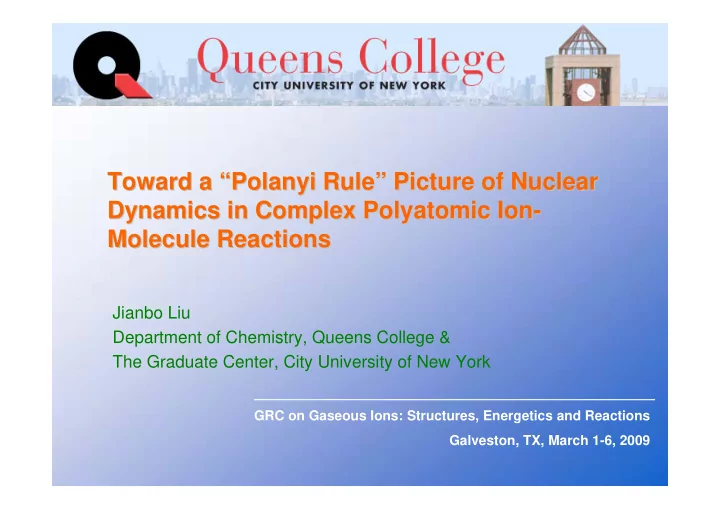

Toward a “ “Polanyi Rule Polanyi Rule” ” Picture of Nuclear Picture of Nuclear Toward a Dynamics in Complex Polyatomic Ion- - Dynamics in Complex Polyatomic Ion Molecule Reactions Molecule Reactions Jianbo Liu Department of Chemistry, Queens College & The Graduate Center, City University of New York GRC on Gaseous Ions: Structures, Energetics and Reactions Galveston, TX, March 1-6, 2009
Properties of the System Early Time Dynamics Hydrogen eV + Abstraction! 0.5 + (classical) +CH 3 C 2 H 3 ( H=0.23eV) + + + CH 4 C 2 H 2 0.0 + (bridged) +CH 3 C 2 H 3 2 H or H2 . ( H=0.05eV) 1 0 1.25 2.01 Elimination! -0.5 TS2 classical TS1 bridged complex + + H ( H=-0.93eV) complex C 3 H 5 -1.0 1.87 1.23 1.66 + + H 2 ( H=-1.32eV) 5 6 1 . 4 5 . C 3 H 4 1 1 . 2 2 1.66 -1.5 -2.0 -2.5 + C 3 H 6 -3.0
Summary of Experimental Results + with two quanta Excitation of C 2 H 2 60 + 2 ) of cis-bending (2 5 + , 0.155 eV) C 2 H 3 gs Cross Section (Å 2 5 + (cis-bending) 40 20 0 0 1 2 3 4 Collsion Energy (eV) Y. Chiu, H. Fu, J. Huang, and S. L. Anderson. JCP, 102, 1199(1995)
Direct Dynamics Simulations on C 2 H 2+ + CH 4 : Nature and Time Scale of Nuclear Motions 5.0 Set initial conditions using Hase’s VENUS CM dist (represent expt. conditions) 4.0 CH 4 CH - E col : 0.5 eV new CH Distance (? + (gs and 2 5 3.0 + ) - Vibrational states: C 2 H 2 - Integrate trajectory using G03 turning point * * 2.0 - MP2/6-31+G* with “SCF=XQC” option 1.0 0 100 200 300 400 H abstraction -116.92 occurs on rebound Potential Energy (Hartree) * -116.93 50 fs -116.94 -116.95 -116.96 -116.97 0 100 200 300 400 Time (fs)
Trajectory Validation: Cross Sections & Product Ion Angular Distribution Opacity Functions for Hydrogen Abstraction 1.2 gs 1.0 + 2 5 0.8 P(b) x b 0.6 100 80 Radial Velocity (m/s) 1500 120 60 0.4 140 40 1000 0.2 1.0 0.0 2.5 2.0 1.5 160 20 500 0.5 0.0 0.5 1.0 1.5 2.0 2.5 3.0 3.5 4.0 3.0 Impact parameter b (? b=3.5 b=0.1 0 180 0 -1500 -1000 -500 V CM 0 500 1000 1500 (HA) exp traj Axial Velocity (m/s) + CH C H Ground state 16 8.1 4 2 2 + state 2 5 42 12.6 Enhancement 2.6 1.6 Trajectories qualitatively reproduce vibrational enhancement effects and angular distribution!
Trajectory Validation: Cross Sections & Product Ion Angular Distribution Opacity Functions for Hydrogen Abstraction 1.2 gs 1.0 traj calculated + 2 5 E col = 0.5 eV 0.8 P(b) x b <V CM > 0.6 100 80 Radial Velocity (m/s) 1500 120 60 0.4 140 40 1000 0.2 1.0 0.0 2.5 2.0 1.5 160 20 500 0.5 0.0 0.5 1.0 1.5 2.0 2.5 3.0 3.5 4.0 3.0 Anderson's exp Impact parameter b (? b=3.5 b=0.1 0 E col = 0.8 eV 180 0 -1500 -1000 -500 V CM 0 500 1000 1500 (HA) exp traj Axial Velocity (m/s) + CH C H Ground state 16 8.1 4 2 2 + state 2 5 42 12.6 Enhancement 2.6 1.6 -2500-2000-1500-1000 -500 0 500 1000 1500 2000 2500 CM Frame Axial Velocity (m/s) Trajectories qualitatively reproduce vibrational enhancement effects and angular distribution!
+ bending Effects of C 2 H 2 At beginning of trajectories 25 fs before CM turning points at CM turning points 0.5 0.4 0.3 ground state Distribution Probability Distribution Probability Distribution Probability 0.4 2 5 + Distribution 0.3 0.2 + 0.3 of C 2 H 2 0.2 bend angle 0.2 0.1 0.1 0.1 0.0 0.0 0.0 60 90 120 150 180 60 90 120 150 180 60 90 120 150 180 H-C-C (degree) H-C-C (degree) H-C-C (degree) 0.10 0.14 0.10 ground state Contribution to Reaction Contribution to Reaction Contribution to Reaction 0.12 ? + 2 5 0.08 0.08 0.10 Cross section 0.06 0.06 0.08 as a function 0.06 0.04 Of bend angle 0.04 0.04 0.02 0.02 Distortion 0.02 0.00 0.00 0.00 60 90 120 150 180 60 90 120 150 180 60 90 120 150 180 H-C-C (degree) H-C-C (degree) H-C-C (degree)
Toward A “ Polanyi-type” Picture for Polyatomic System 90 H plane + bend angle (degree) 120 H Saddle point C H Product H * rCH 150 C H H-C-C 180 Reactant C -150 H C 2 H 2 -120 -90 1 2 3 4 5 6 rCH (Å) E col = 0.5 eV, and C 2 H 2 + (gs)
Toward A “ Polanyi-type” Picture for Polyatomic System Reactant E vib 90 A+BC AB+C + bend angle (degree) 120 Saddle point Product * 150 180 Reactant -150 Reactant E col C 2 H 2 -120 -90 1 2 3 4 5 6 rCH (Å) + (2 5 E col = 0.5 eV, and C 2 H 2 + ) with E vib = 0.15 eV
Origins of Vibrational Effects on Reactions: Distortion vs. Momentum Acknowledgements Scott Anderson (U of Utah) ACS-PRF Grant CUNY Collaboration Grant
Biochemical ion- -molecule reactions molecule reactions Biochemical ion + 1 O 2
Recommend
More recommend